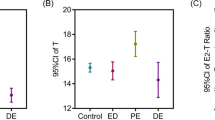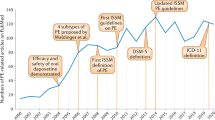Abstract
The aim of this study was to investigate the relationship between metabolic syndrome (MetS) and acquired premature ejaculation (PE). A total of 100 patients with acquired PE and 100 control cases were enrolled in the study. After obtaining a detailed medical history, anthropometric (weight, height and waist circumference) and blood pressure measurements were performed. Ejaculation and erection functions were evaluated by Premature Ejaculation Diagnostic Tool (PEDT) and International Index of Erectile Function-5 (IIEF-5), respectively. Self-estimated intravaginal ejaculatory latency time (IELT) of the participants was recorded. Fasting blood samples were taken for biochemical and hormonal work-up. The median PEDT scores were 16 (9–22) and 4.5 (2–8) in acquired PE and control groups, respectively (P<0.001). The mean estimated IELT values in PE patients and controls were 36.1±46.5 versus 488.2±313.8 s (P<0.001). MetS was diagnosed in 51 patients (51%) in the PE group and 24 (24%) participants in the control group (P<0.001). A significant negative correlation was observed between the components of MetS and estimated IELT, except for diastolic blood pressure. Moreover, there was a significant positive correlation between the all components of MetS and total PEDT score, except for fasting blood glucose and high-density lipoprotein cholesterol (HDL) levels. Logistic regression analysis revealed that, except blood pressure and HDL levels, MetS components were significant risk factors for PE after adjusting for age and total testosterone. In conclusion, MetS is associated with acquired PE.
This is a preview of subscription content, access via your institution
Access options
Subscribe to this journal
Receive 8 print issues and online access
$259.00 per year
only $32.38 per issue
Buy this article
- Purchase on Springer Link
- Instant access to full article PDF
Prices may be subject to local taxes which are calculated during checkout
Similar content being viewed by others
References
Laumann EO, Paik A, Rosen RC . Sexual dysfunction in the United States: prevalence and the predictors. JAMA 1999; 281: 537–544.
Serefoglu EC, McMahon CG, Waldinger MD, Althof SE, Shindel A, Adaikan G et al. An evidence-based unified definition of lifelong and acquired premature ejaculation: report of the second International Society for Sexual Medicine Ad Hoc Committee for the Definition of Premature Ejaculation. J Sex Med 2014; 11: 1423–1441.
Cihan A, Demir O, Demir T, Aslan G, Comlekci A, Esen A . The relationship between premature ejaculation and hyperthyroidism. J Urol 2009; 181: 1273–1280.
Lee JH, Lee SW . Relationship between premature ejaculation and chronic prostatitis/chronic pelvic pain syndrome. J Sex Med 2015; 12: 697–704.
Lotti F, Corona G, Mancini M, Biagini C, Colpi GM, Innocenti SD et al. The association between varicocele, premature ejaculation and prostatitis symptoms: possible mechanisms. J Sex Med 2009; 6: 2878–2887.
Corona G, Jannini EA, Vignozzi L, Rastrelli G, Maggi M . The hormonal control of ejaculation. Nat Rev Urol 2012; 9: 508–519.
Expert Panel on Detection, Evaluation, and Treatment of High Blood Cholesterol in Adults. Executive summary of the third report of The National Cholesterol Education Program (NCEP) expert panel on detection, evaluation, and treatment of high blood cholesterol in adults (Adult Treatment Panel III). JAMA 2001; 285: 2486–2497.
Ford ES, Giles WH, Dietz WH . Prevalence of the metabolic syndrome among US adults: findings from the third National Health and Nutrition Examination Survey. JAMA 2002; 287: 356–359.
Gorgel SN, Gorgel A, Sefik E . Sexual function in male patients with metabolic syndrome and effective parameters on erectile dysfunction. Int Braz J Urol 2014; 40: 56–61.
Corona G, Mannucci E, Petrone L, Schulman C, Balercia G, Fisher AD et al. A comparison of NCEP-ATPIII and IDF metabolic syndrome definitions with relation to metabolic syndrome-associated sexual dysfunction. J Sex Med 2007; 4: 789–796.
Lee JH, Kwon H, Park YW . Association of lower urinary tract symptom/benign prostatic hyperplasia measures with international index of erectile function 5 in middle-aged policemen of Korea and the role of metabolic syndrome and testosterone in their relationship. Urology 2013; 82: 1008–1012.
Gacci M, Corona G, Vignozzi L, Salvi M, Serni S, De Nunzio C et al. Metabolic syndrome and benign prostatic enlargement: a systematic review and meta-analysis. BJU Int 2015; 115: 24–31.
Corona G, Rastrelli G, Vignozzi L, Mannucci E, Maggi M . How to recognize late-onset hypogonadism in men with sexual dysfunction. Asian J Androl 2012; 14: 251–259.
Heidler S, Temml C, Broessner C, Mock K, Rauchenwald M, Madersbacher S et al. Is the metabolic syndrome an independent risk factor for erectile dysfunction? J Urol 2007; 177: 651–654.
Han TS, Tajar A, O'Neill TW, Jiang M, Bartfai G, Boonen S et al. Impaired quality of life and sexual function in overweight and obese men: the European Male Aging Study. Eur J Endocrinol 2011; 164: 1003–1011.
El-Sakka AI . Premature ejaculation in non-insulin-dependent diabetic patients. Int J Androl 2003; 26: 329–334.
Serefoglu EC, Cimen HI, Ozdemir AT, Symonds T, Berktas M, Balbay MD . Turkish validation of the premature ejaculation diagnostic tool and its association with intravaginal ejaculatory latency time. Int J Impot Res 2009; 21: 139–144.
Symonds T, Perelman MA, Althof S, Giuliano F, Martin M, May K et al. Development and validation of a premature ejaculation diagnostic tool. Eur Urol 2007; 52: 565–573.
Rosen RC, Cappelleri JC, Smith MD, Lipsky J, Pena BM . Development and evaluation of an abridged, 5-item version of the International Index of Erectile Function (IIEF-5) as a diagnostic tool for erectile dysfunction. Int J Impot Res 1999; 11: 319–326.
McMahon CG, Jannini EA, Serefoglu EC, Hellstrom WJ . The pathophysiology of acquired premature ejaculation. Transl Androl Urol 2016; 5: 434–449.
Serefoglu EC, Yaman O, Cayan S, Asci R, Orhan I, Usta MF et al. Prevalence of the complaint of ejaculating prematurely and the four premature ejaculation syndromes: results from the Turkish Society of Andrology Sexual Health Survey. J Sex Med 2011; 8: 540–548.
Zhang X, Gao J, Liu J, Xia L, Yang J, Hao Z et al. Distribution and factors associated with four premature ejaculation syndromes in outpatients complaining of ejaculating prematurely. J Sex Med 2013; 10: 1603–1611.
Gao J, Zhang X, Su P, Liu J, Xia L, Yang J et al. Prevalence and factors associated with the complaint of premature ejaculation and the four premature ejaculation syndromes: a large observational study in China. J Sex Med 2013; 10: 1874–1878.
Jannini EA, McCabe MP, Salonia A, Montorsi F, Sachs BD . Organic vs. psychogenic? The Manichean diagnosis in sexual medicine. J Sex Med 2010; 7: 1726–1733.
Beltrán-Sánchez H, Harhay MO, Harhay MM, McElligott S . Prevalence and trends of metabolic syndrome in the adult U.S. population, 1999-2010. J Am Coll Cardiol 2013; 62: 697–703.
Corona G, Mannucci E, Schulman C, Petrone L, Mansani R, Cilotti A et al. Psychobiologic correlates of the metabolic syndrome and associated sexual dysfunction. Eur Urol 2006; 50: 595–604.
Maseroli E, Corona G, Rastrelli G, Lotti F, Cipriani S, Forti G et al. Prevalence of endocrine and metabolic disorders in subjects with erectile dysfunction: a comparative study. J Sex Med 2015; 12: 956–965.
Isidro ML . Sexual dysfunction in men with type 2 diabetes. Postgrad Med J 2012; 88: 152–159.
Maiorino MI, Bellastella G, Esposito K . Diabetes and sexual dysfunction: current perspectives. Diabetes Metab Syndr Obes 2014; 7: 95–105.
Bellastella G, Maiorino MI, Olita L, Della Volpe E, Giugliano D, Esposito K . Premature ejaculation is associated with glycemic control in type 1 diabetes. J Sex Med 2015; 12: 93–99.
Majzoub A, Arafa M, Al-Said S, Dabbous Z, Aboulsoud S, Khalafalla K et al. Premature ejaculation in type II diabetes mellitus patients: association with glycemic control. Transl Androl Urol 2016; 5: 248–254.
Saenz de Tejada I, Goldstein I . Diabetic penile neuropathy. Urol Clin North Am 1988; 15: 17–22.
Martín-Cora FJ, Fornal CA, Metzler CW, Jacobs BL . Insulin induced hypoglycemia decreases single-unit activity of serotonergic medullary raphe neurons in freely moving cats: relationship to sympathetic and motor output. Eur J Neurosci 2002; 16: 722–734.
Francomano D, Donini LM, Lenzi A, Aversa A . Peripheral arterial tonometry to measure the effects of vardenafil on sympathetic tone in men with lifelong premature ejaculation. Int J Endocrinol 2013; 2013: 394934.
Eriksson AK, Ekbom A, Granath F, Efendic S, Ostenson CG . Psychological distress and risk of pre-diabetes and type 2 diabetes in a prospective study of Swedish middle-aged men and women. Diabet Med 2008; 25: 834–842.
Huang ES, Brown SE, Ewigman BG, Foley EC, Meltzer DO . Patient perceptions of quality of life with diabetes-related complications and treatments. Diabetes Care 2007; 30: 2478–2483.
Moreira MC, Pinto IS, Mourão AA, Fajemiroye JO, Colombari E, Reis ÂA et al. Does the sympathetic nervous system contribute to the pathophysiology of metabolic syndrome? Front Physiol 2015; 6: 234.
Zorba OU, Cicek Y, Uzun H, Çetinkaya M, Önem K, Rifaioğlu MM . Autonomic nervous system dysfunction in lifelong premature ejaculation: analysis of heart rate variability. Urology 2012; 80: 1283–1286.
Xia JD, Han YF, Zhou LH, Xu ZP, Chen Y, Dai YT . Sympathetic skin response in patients with primary premature ejaculation. Int J Impot Res 2014; 26: 31–34.
Lee JH . Associations between premature ejaculation, lower urinary tract symptoms, and erectile dysfunction in middle-aged Korean policemen. J Sex Med 2014; 11: 1512–1518.
Ventus D, Jern P . Lifestyle factors and premature ejaculation: are physical exercise, alcohol consumption, and body mass index associated with premature ejaculation and comorbid erectile problems? J Sex Med 2016; 13: 1482–1487.
Lee SW, Lee JH, Sung HH, Park HJ, Park JK, Choi SK et al. The prevalence of premature ejaculation and its clinical characteristics in Korean men according to different definitions. Int J Impot Res 2013; 25: 12–17.
Jannini EA, Lombardo F, Lenzi A . Correlation between ejaculatory and erectile dysfunction. Int J Androl 2005; 28 (Suppl 2):40–45.
Inman BA, Sauver JL, Jacobson DJ, McGree ME, Nehra A, Lieber MM et al. A population-based, longitudinal study of erectile dysfunction and future coronary artery disease. Mayo Clin Proc 2009; 84: 108–113.
Corona G, Rastrelli G, Limoncin E, Sforza A, Jannini EA, Maggi M . Interplay between premature ejaculation and erectile dysfunction: a systematic review and meta-analysis. J Sex Med 2015; 12: 2291–2300.
Corona G, Jannini EA, Mannucci E, Fisher AD, Lotti F, Petrone L et al. Different testosterone levels are associated with ejaculatory dysfunction. J Sex Med 2008; 5: 1991–1998.
Schneider G, Kirschner MA, Berkowitz R, Ertel NH . Increased estrogen production in obese men. J Clin Endocrinol Metab 1979; 48: 633–638.
El-Sakka AI, Hassoba HM, Sayed HM, Tayeb KA . Pattern of endocrinal changes in patients with sexual dysfunction. J Sex Med 2005; 2: 551–558.
Acknowledgements
Author contributions
DB designed the project, collected the data and wrote the paper. DB, MEA and GUK collected the data. DB, OA performed the statistical analysis. BG performed the critical revision of the manuscript. All authors read and approved the final manuscript.
Author information
Authors and Affiliations
Corresponding author
Ethics declarations
Competing interests
The authors declare no conflict of interest.
Rights and permissions
About this article
Cite this article
Bolat, D., Kocabas, G., Gunlusoy, B. et al. The relationship between acquired premature ejaculation and metabolic syndrome: a prospective, comparative study. Int J Impot Res 29, 105–109 (2017). https://doi.org/10.1038/ijir.2017.3
Received:
Revised:
Accepted:
Published:
Issue Date:
DOI: https://doi.org/10.1038/ijir.2017.3
This article is cited by
-
Frequency of etiological factors among patients with acquired premature ejaculation: prospective, observational, single-center study
International Journal of Impotence Research (2020)



